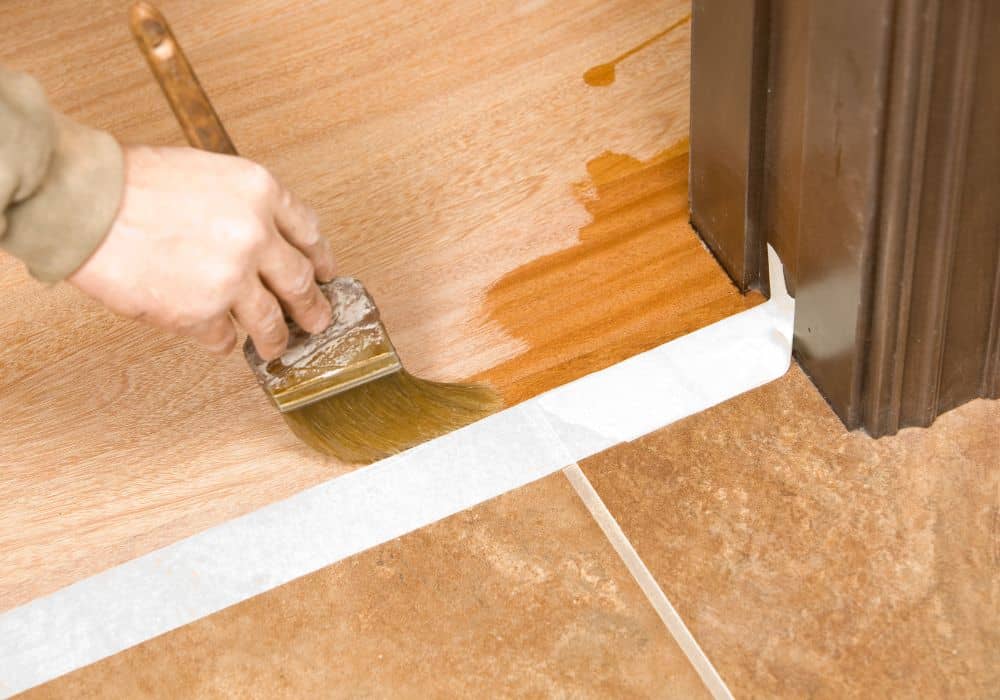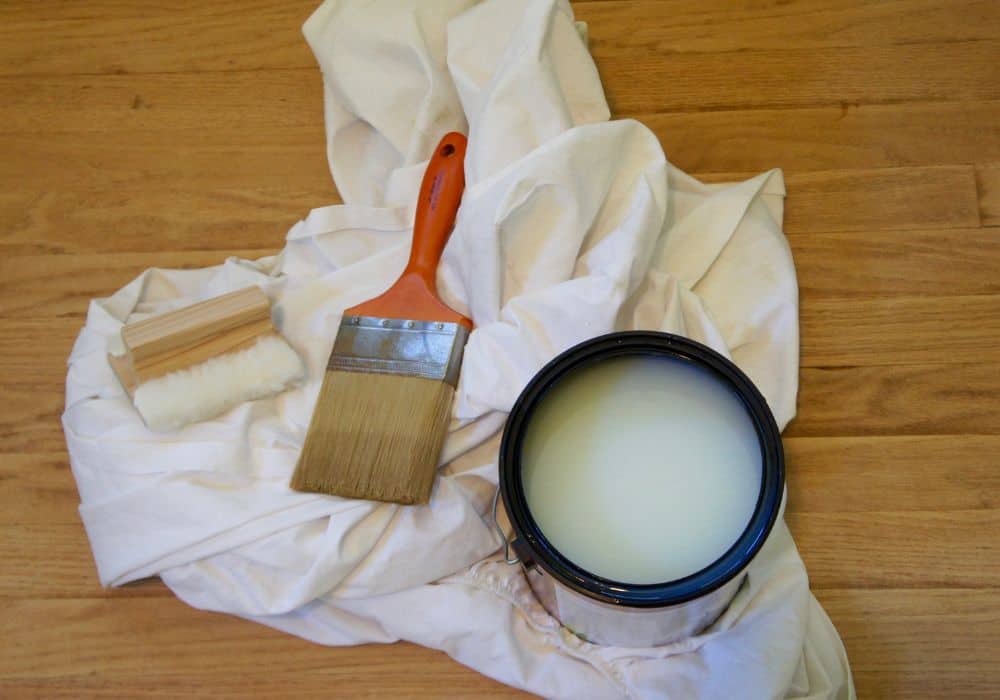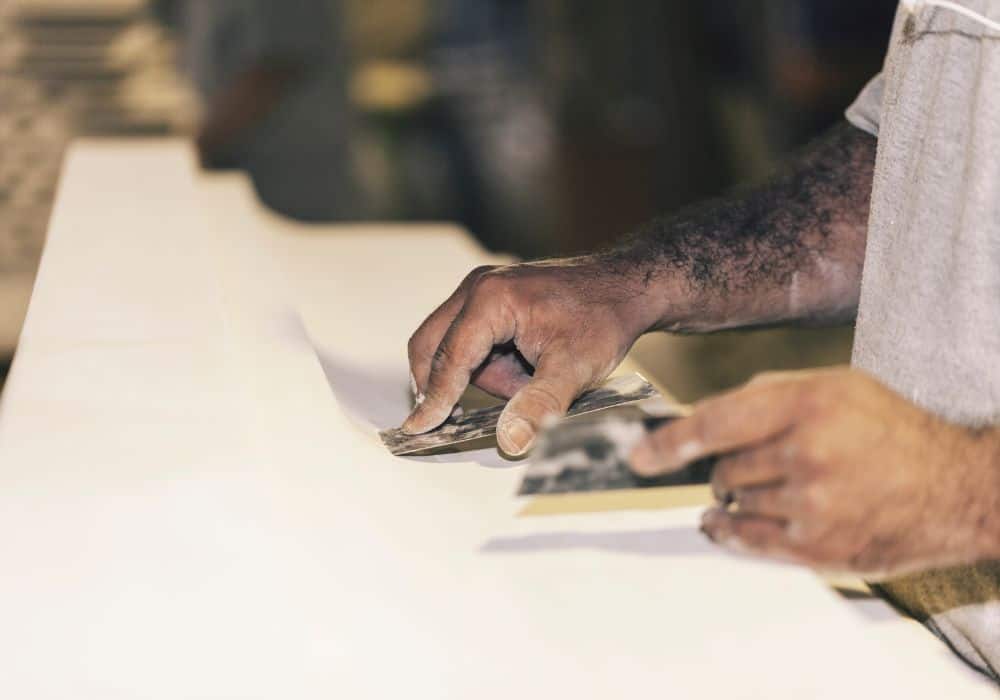Polyurethane coats provide a clear and durable finish for different types of wooden surfaces. It strengthens the area while also making it look perfect. But how many coats of polyurethane do you need to use?
Generally, the number of coats you need depends on the material you’re applying it on and the finish you’re looking for. Here we’ll see how many coats you need for each situation and the dangers of applying too many coats. Let’s get started!
Table of Contents
How Many Coats of Polyurethane are Needed?
The bare minimum number of polyurethane coats you’ll need is two, however, it’s usually best to apply at least three coats. The exact number of coats you’ll need will depend on the surface you’re covering and the type of polyurethane you’re using.
One of the biggest factors is how often the surface is going to be used. For example, tabletops often have a lot of daily use and therefore will need more coats. Decorative furniture won’t have the same daily demands and therefore wouldn’t need as many coats.
For most surfaces such as doors, chairs, tables, and trim, three to four coats are usually enough the get the protection you need, and the shiny finish desired. Another significant factor is the type of polyurethane that you are using.
Water-based polyurethanes are quite thin and therefore would need more layers. Here around four to five coats are needed to get the desired effect. Usually, with water-based products, the drying time will be quick, at around two hours.
Oil-based polyurethane is thicker, and therefore fewer coats are required. Here you’ll only need three to four coats, however, the drying time is going to be longer. You’ll often need to wait four to six hours between coats.
You may be wondering whether you can get away with just one coat of polyurethane, but the answer is no. The finish won’t be great, and it’s not going to offer a lot of protection. Added to this, there is a high chance you’ll see the brush marks, and bubbles can form too.
What is Polyurethane?
Polyurethane is a clear coat varnish often used for protecting wooden surfaces like countertops, tables, and floors. It is also durable because when polyurethane dries, the microscopic resin molecules bond.
Because of these elements, the coating ends up becoming highly resistant to water, abrasions, impact, solvents, and other types of damage.
Polyurethane can either be oil or water-based. Out of the two types, oil-based polyurethane has been around longer, while the water-based category has only been developed recently.
1. Oil-Based Polyurethane
These types of polyurethane have a thick consistency and are durable when cured. It can be challenging to acquire because of the high-level VOCs (volatile organic compounds) it produces.
When using an oil-based product, many people ask if one coat of polyurethane is enough. Generally, you’ll need between three and four coats of polyurethane to get the best results. The varnish takes some time to dry, so you’ll have to wait longer in-between coats.
Once it’s dry, this type of varnish will leave an attractive amber hue over the object’s surface. And if you have lighter wood like birch or oak, you’ll see a lighter effect which adds more warmth to its color.
If there is any excess polyurethane, you can easily clean these up using mineral spirits. To use this, pour the mineral spirit onto a clean and soft cloth before wiping the surface to clean the area.
2. Water-Based Polyurethane
Water-based polyurethane is a better type of varnish since it’s safer for you and the environment. It emits lower VOCs, and it dries faster than oil-based polyurethane. Plus, it also levels itself automatically, which is more convenient.
While this type of polyurethane is excellent to work with because of minimal odor, you should still be careful when using it. Although it’s water-based, it can still cause the wood grain to lift.
The effects of water-based polyurethane on wood surfaces will probably leave you wondering how many coats are necessary. You’ll need a few coats of this varnish because of the raised wood grain and its watery consistency. This means you’ll need extra coats of water-based polyurethane to smoothen the object’s surface.
At first, you’ll notice that this type of polyurethane has a milky-white appearance. Don’t be alarmed because once it dries, the varnish will be as clear as crystal. This makes it perfect for preserving the natural tone of wooden surfaces.
Additionally, water-based polyurethane is less likely to get yellow as time passes. When cleaning this type of polyurethane, you can simply use soap and water. Also, once this has been cured, avoid using ammonia-based cleaners on it.
Number of Coats of Polyurethane for Different Surfaces
Knowing how many coats of polyurethane to apply is critical for achieving a good result. Multiple coats are required for proper protection of the wood. For oil-based finishes, require fewer layers than water-based finishes. Oil-based polyurethane has a thicker consistency and produces excellent results after three or four coats.
The number of coats of polyurethane you apply depends on how much use the surface will receive. It’s also based on the level of protection it requires.
Water-based polyurethane needs four to five coats since this is thinner than an oil-based one. Generally, different types of wood require varying amounts of polyurethane. So applying multiple coats of polyurethane to a specific wooden surface guarantees shine and protection.
Here are the various surfaces and the number of coats required for each:
- Indoor Furniture – To get the results you want, it’s best to apply at least two coatings of polyurethane to your furniture. If you use the furniture a lot, we suggest applying three coatings of oil-based polyurethane instead. If you’re using water-based polyurethane, give it at least four coats.
- Outdoor Furniture – You can use three coats of the water-based type on your furniture placed outdoors. However, make sure to use polyurethane that has UV protection since the furniture will be under direct sunlight. Additionally, make sure that it’s labeled for external use to ensure that chipping is prevented.
- Cabinets – Apply three or four coats of polyurethane to the cabinets to achieve a professional-looking finish. If you use more coats, these can significantly improve the appearance and finish of your cabinet.
- Doors – Water-based polyurethane can be applied to an interior wooden surface up to five times. On an even surface, use a spray or bristle brush to apply the varnish. Allow the first coat to dry completely before applying the next layer.
- Wood Countertops – Two coats of polyurethane are required for your wood countertops. If the surface is heavily and regularly used, you’ll need a third coating for it. When using water-based polyurethane, you can apply more than two coats since it tends to raise the wood grains.
- Kitchen Table – On a kitchen table, three coats of polyurethane are sufficient. Kitchen tables can be subject to abrasive conditions such as cutlery scratching, liquid spillage, and pot banging. As a result, it requires additional safeguards. The finish would be more durable if three coats were used.
- Staircase – On stairs, we recommend two coats of oil-based polyurethane. Three coats are ideal for added step protection and slip resistance, while four or more are ideal for water-based polyurethane. After eight hours, reapply the oil-based polyurethane. But with the water-based type, you can reapply it after two hours.
How to Apply Polyurethane
The process here isn’t too difficult, and anyone would be able to do it. While not too technical, it does require patience. Due to the time needed for layers to dry properly, it can take a few days before you get all the coats you need. Here are the steps you need to take:
Step1. Cleaning the Surface
Before you apply polyurethane, you need to be happy with what’s beneath it. If there is any dust or dirt, then it’s going to stay trapped below the surface. This is why you need to make sure that the area is clean and free of any debris.
If you’re working on wood, then it’s usually the best idea to sand it before applying any coat. This will expose a beautiful fresh layer of wood which you can then protect with polyurethane. Just make sure all the dust is wiped away.
Step2. Get Prepared
There is no requirement to wear gloves and a mask when applying polyurethane, but many like to. Gloves especially can be useful as otherwise, it’s likely that you’ll get some polyurethane on your hands.
Once you’re ready, then it’s a good idea to stir it before sticking your brush in there. Like with paint, there is a chance that some of the compounds have separated. For the best possible finish, make sure it’s all mixed together.
Step3. Brush on the Polyurethane
You can apply the first coat as you would do with paint, and a bristle brush is a good tool for it. That being said, some prefer to use a foam brush to ensure there are no marks. Make sure you apply the first coat liberally and don’t leave any thin spots.
Once you’ve double-checked that all the areas have been covered, you can let it dry. While you need to ensure every coat is dried before adding a new one, this is especially important for the first layer. The exact waiting time can vary, so it’s best to check what it says on the tin.
Step4. Apply the Rest of Your Coats
Now you can continue to add layers until you are happy with the finish. Before each coat, it’s good to check that it’s fully dry. Once it is, give it a light sanding to ensure an even finish and so that the next coat bonds well to it. You may want to thin your polyurethane for the top coat so that it doesn’t drip or leave brush marks.
Applying too Many Layers of Polyurethane
The smoothness of the polyurethane finish on your furniture is determined by the number of coats applied. So, what happens if you apply more layers than necessary?
- You’ll Get Uneven Layers – When you apply unnecessary numbers of polyurethane coats, it will cause unevenness to the layers. You can still fix this by sanding the uneven areas before reapplying the varnish. However, we suggest applying only the necessary amount for the surface.
- Yellow Look Finish – Too much polyurethane coating gives the material a yellowish appearance. And unfortunately, this will worsen over time due to oxidation. To remedy the situation, scrape away the old layer that has a yellowing finish. You can use either dry or wet sandpaper. To get the finish you want, reapply adequate amounts of polyurethane to the surface.
- Peeling – If you apply too many coatings of polyurethane, these will get thicker and softer which will result in peeling. When you see peels due to over-coating, immediately get a razor blade, then scuff those peels away. Sand the area to get a better finish before reapplying the right amount of polyurethane.
- Longer Waiting Time – You’ll end up waiting longer when more coats are applied since each layer needs to dry before reapplying. So, it’s best to follow the recommended coats on specific materials to prevent damaging your surfaces.
Remember: more is not always better. Unnecessarily applying too many coats can damage the material of your furniture instead of protecting it. To avoid this, follow the recommended coats and fix any damage to increase the durability of the surface.
Conclusion
Polyurethane has many advantages in terms of increasing the durability of the material. Plus, it’s flexible and versatile enough to use for everyday materials. Also, polyurethane can add beauty and charm to your home.
So how many polyurethane coats are required on wood surfaces? For oil-based polyurethane, you need three to four coats, while its wait time is eight hours per coat. For water-based polyurethane, you’ll need four to five coats, and its waiting time is two hours per coat.
Now you know how many coats of polyurethane are necessary for your surfaces. With that, you won’t have to worry about it whenever you want to work on your furniture.


